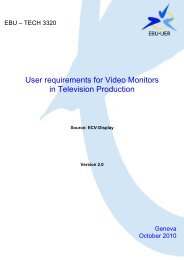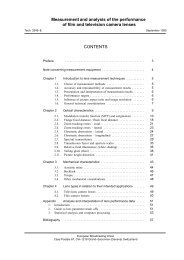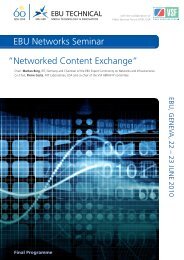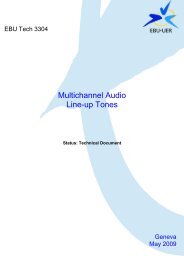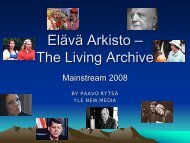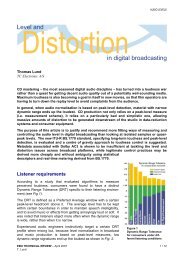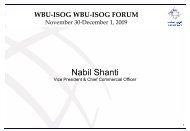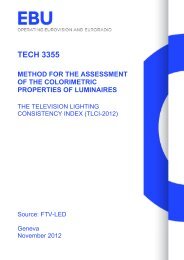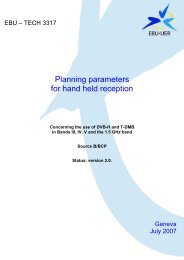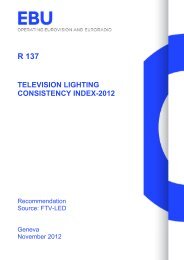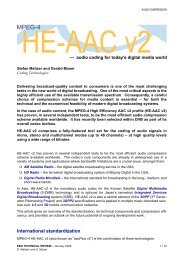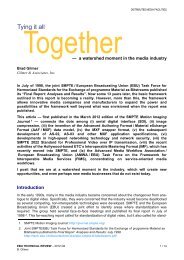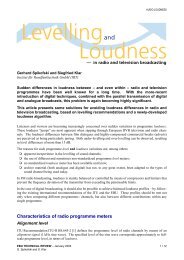Production Technology Seminar 2009 - EBU Technical
Production Technology Seminar 2009 - EBU Technical
Production Technology Seminar 2009 - EBU Technical
You also want an ePaper? Increase the reach of your titles
YUMPU automatically turns print PDFs into web optimized ePapers that Google loves.
2 IT-based production and archives<br />
Chairperson: Vieslaw Lodzikowski, TVP, Poland<br />
Because broadcasters need to deliver richer content across a large number of delivery platforms,<br />
production needs to meet new business requirements. Sharing resources and combining best of breed<br />
market solutions is key. Will file-based production and new architectures fulfil their promises?<br />
Service-oriented Architecture<br />
2.1 File-based production: problem solved?<br />
Giorgio Dimino, RAI Research Centre, Italy<br />
The concept was introduced 10-12 years ago. The "<strong>EBU</strong>-SMPTE Task Force for Harmonized Standards<br />
for the Exchange of Programme Material as Bit-streams" started to think of the future TV infrastructure<br />
based on computer technology. It was a fundamental think tank, which gave birth to most of the<br />
concepts and standards that we are using today: compression formats in TV production, file wrappers<br />
(AAF,MXF), metadata (SMPTE dictionary, UMID), exchange of content as file (file transfer, streaming)…<br />
It formulated the need for a level of "system management services" and for a "Reference Object Model<br />
for System Management in order to insure interoperability in the longer term". Up to then, broadcast<br />
infrastructure was based on audio/video interfaces and cabling. Now, with IT-based technologies,<br />
interfacing is much more complex, you need more intelligence, formats and models. But at the time there<br />
was not enough knowledge of the processes we factorised in the view of IT technology to be able to<br />
build a sound model. The follow-up of this work was undertaken by several <strong>EBU</strong> projects [4], providing<br />
clear advances.<br />
Many broadcasters have implemented IT-based production islands (self-contained), but very few have<br />
been able to integrate all of these islands into a coherent production system. The system organisation is<br />
still video-centric in most cases, and sometimes it is even faster than trying to integrate the islands,<br />
because of the lack of common interfaces. And even when the system integration is implemented, it is<br />
based on proprietary solutions. That means that the technology migration, the extension of the system<br />
and of the workflow is a challenge and is expensive. This is because, each time, you have to redo a part<br />
of the system integration work. Especially when several manufacturers update their product<br />
independently from each other and then apply the upgrade on one part, you have also to upgrade all the<br />
others and perhaps rework the interfaces.<br />
As an example, a very simplified scheme with different production islands [6], with different equipment of<br />
different manufacturers designed at different times. When you want to interconnect them, you have to<br />
define a custom interface at both ends. That may be not very efficient in many cases, because it was not<br />
meant from the beginning, and sometimes simply because the formats do not match. So, it is difficult to<br />
run the workflow around it. In some case, you want to use some resources that have been installed for<br />
another similar facility, you want to put them together… and again you need a specific interface. And<br />
when you get rid of one of the components, you probably have to rework the interface. So this is adding<br />
cost and you never know where and when this story is going to end. We have also to keep in mind that<br />
in the IT world nothing lasts more than a few years. It is not economical to keep running a system that is<br />
older, because the maintenance costs are in many cases higher than rebuilding the system with updated<br />
technologies…<br />
Our vision is to:<br />
� redefine integration as a pool of production resources interconnected over a network via standardized<br />
interfaces<br />
� implement workflows via a resource orchestrator that just calls resources and chain them, these<br />
workflows being supported by management services<br />
© <strong>EBU</strong> <strong>2009</strong> / <strong>Production</strong> <strong>Technology</strong> seminar / January 27 - 29, <strong>2009</strong><br />
Reproduction prohibited without written permission of <strong>EBU</strong> TECHNICAL & <strong>EBU</strong> TRAINING<br />
21



